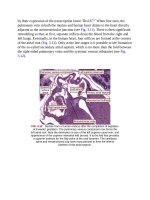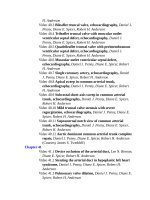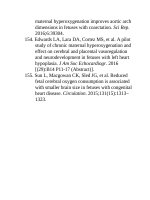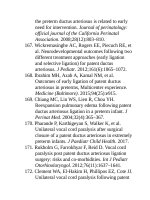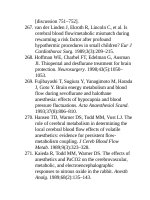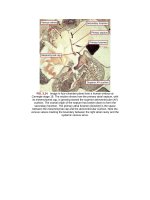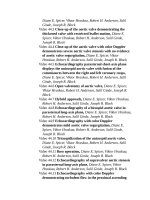Andersons pediatric cardiology 1061
Bạn đang xem bản rút gọn của tài liệu. Xem và tải ngay bản đầy đủ của tài liệu tại đây (200.45 KB, 3 trang )
valves,inwhichvirtuallywithoutexceptionthecoronaryarteriesarisefromone
orotheroftheaorticvalvarsinusesadjacenttothepulmonarytrunk,andusually
bothsinuses,thereisnoconstantpatternofsinusalorigininthepresenceofa
commonventricularoutflowtract.Instead,thecoronaryarteriescanarisefrom
anyofthetruncalvalvarsinuses,albeitthatinmostinstancestherearestilltwo
coronaryarteries,withtheleftarterygivingrisetoanteriorinterventricularand
circumflexbranches.Thearteriesoftenariseclosetoazoneofapposition
betweenthevalvarleaflets,andoriginabovethesinutubularjunctionisquite
common.Thiscanproducepotentialdifficultiesduringsurgicalcorrection
shouldthehighoriginbeadjacenttotheoriginofthepulmonaryarteries.
Knowledgeoflocationoftheatrioventricularconductionaxisisalso
importantwhenplanningsurgicalrepair.Thesinusnodeandtheatrioventricular
nodearenormalintheirlocationandstructure.Havingtakenoriginfromthe
atrioventricularnode,thepenetratingatrioventricularbundlepiercesthroughthe
centralfibrousbody,andtheleftbundlebranchoriginatesalongtheleft
ventricularseptalendocardium(seeChapter3).Therightbundlebranchtravels
withinthemyocardiumoftheventricularseptalcrest,attainingasubendocardial
courseatthelevelofthemoderatorband.Inthoseheartsinwhichamuscular
barinterposesbetweentheattachmentsofthetruncalandtricuspidvalvesinthe
posteroinferiormarginoftheseptaldefect,themembranousseptumisintact
behindthemusculartissue,andtheatrioventricularconductiontissuesare
somewhatdistantfromtherimofthedefect(seeFig.40.3,left).Incontrast,in
patientsinwhomtheventricularseptaldefectisperimembranous,the
conductiontissuepassesdirectlyalongtheleftaspectofthefibrous
posteroinferiorrimofthedefect(seeFig.40.3,right).Itisthenatgreater
surgicalrisk.Wehavealreadymentionedmostofthecommonassociated
cardiovascularanomaliesfoundinthesettingofcommonarterialtrunk,
includingarightaorticarch,interruptedaorticarch,patencyofthearterialduct,
discontinuityofonepulmonaryartery,coronaryarterialanomalies,and
incompetenttruncalvalve.Adefectwithintheovalfossahasbeennotedinupto
one-fifthofpatients,persistenceoftheleftsuperiorcavalveindrainingtothe
coronarysinusinuptoone-tenth,andanaberrantsubclavianarteryinbetween
one-tenthandone-twentieth.8Partiallyanomalouspulmonaryvenousconnection
hasalsobeenreported.11
Morphogenesis
Theevidencenowavailableshowsthatmanycasesofcommonarterialtrunk
resultfromageneticdefect.Theevidencecomesfrominterpretationof
morphology,experimentsinanimals,studiesontheroleofcellsmigratingfrom
theneuralcrestinthedevelopmentoftheoutletcomponentsoftheheartandthe
arterialtrunks,12andthediscoveryofdeletionsinchromosome22q11inpatients
withmalformationsinvolvingtheoutflowtracts—so-calledconotruncal
defects.13,14Themorphologyofcommonarterialtrunksupportsverystrongly
thenotionthat,duringdevelopment,therehasbeenfailureofseptationofthe
ventricularoutletsandtheoutflowsegmentofthehearttube.Ithadbeen
suggestedthattheentitywasproducedinconsequenceoffailureofformationof
thesubpulmonaryinfundibulum,withthecommonarterialtrunkinessence
representingtheaorta.8Noevidencehasaccruedoverthepastdecadesto
supportthislatternotion,butmuchhasappearedtocontradictit.Thusstudiesof
cardiacdevelopment,onbothnormalandabnormalhearts,havealwaysshown
thattheinitiallycommonventricularoutflowtractisseparatedbythecontained
endocardialcushionstoproducetheseparatearterialrootsandtheirsupporting
ventricularoutflowtracts.15Failureofsuchseparationduringembryologic
developmentwasdemonstratedconclusivelyasproducingcommonarterialtrunk
inanelegantstudyusingKeeshonddogspublishedaslongagoas1978.16The
subsequentstudiesofKirbyandcolleaguesshowedthat,whenthemigrationof
thecellsfromtheneuralcrestisperturbed,thecushionsdonotdevelopproperly,
andoneofthelesionsproducediscommonarterialtrunk.17,18Commonarterial
trunkhasnowbeenproducedismultiplemousemodels,suchasthemousewith
perturbationoftheFurinenzyme(Figs.40.7and40.8).Thesestudiesalsoshow
thatthevariationsinpatterningoftheintrapericardialarterialcomponents
dependsontheextentoftheaortopulmonaryseptum,formedbytheprotrusion
fromthedorsalwalloftheaorticsac(seeChapter3).Someoftheperturbed
embryoshaddoublycommittedventricularseptaldefects,ratherthancommon
arterialtrunk.Thisisofparticularinterestbecause,aswehavealready
discussed,themorphologyoftheoutflowtractsisalmostidenticalinthesetting
ofacommonarterialtrunkandindoublycommitteddefects,apartfromthe
findingofseparateaorticandpulmonaryvalvarorificesinthelatter
malformations.
FIG.40.7 Ventriculoarterialjunctionsoftwomouseembryosinwhichthe
Furinenzymewasperturbed.Bothhavecommonarterialtrunk(seeFig.
40.8).Left,Twomajoroutflowcushionshavefailedtofuse,butwithnormal
formationoftheintercalated(IC)cushions.Thesituationwillproducea
quadrifoliatetruncalvalve.Theheartisphotographedfromabove.Right,
Failureoffusionoftheoutflowcushions,butwithabsenceoftheaorticIC
cushion,providingthepotentialforformingatrifoliatetruncalvalve.This
heartisphotographedfromtheapexlookingtowardthecardiacbase.
FIG.40.8 HeartsfrommiceinwhichtheFurinenzymewasperturbed.
Bothheartshavecommonarterialtrunk,butthereisabalanced
arrangementoftheaorticandpulmonarycomponentsofthecommontrunk
